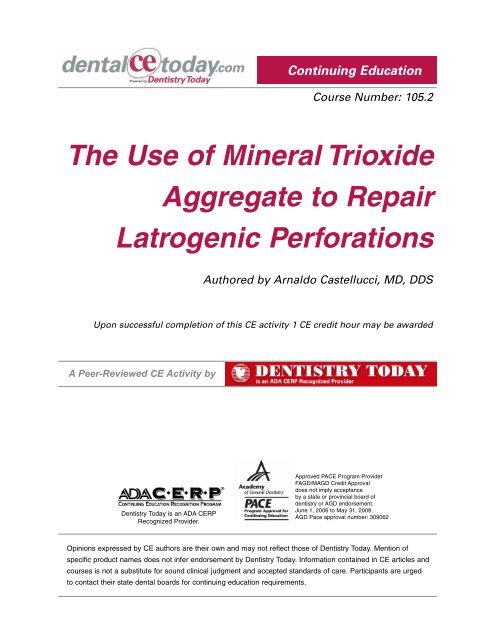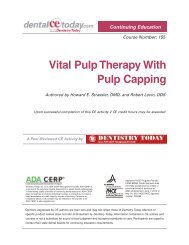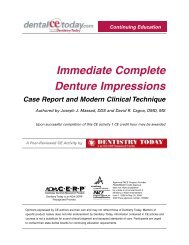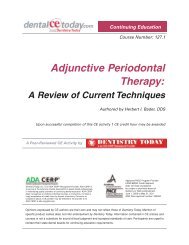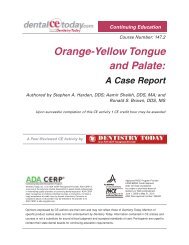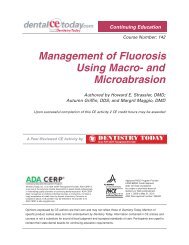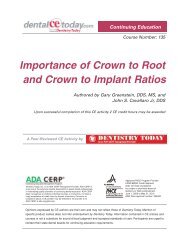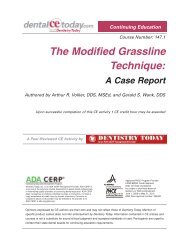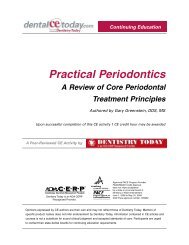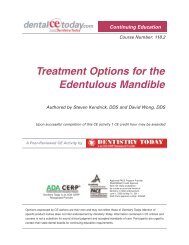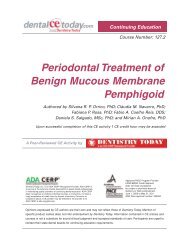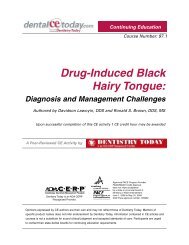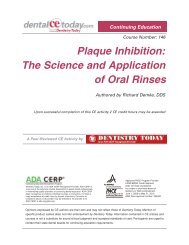The Use of Mineral Trioxide Aggregate to Repair ... - DentalCEToday
The Use of Mineral Trioxide Aggregate to Repair ... - DentalCEToday
The Use of Mineral Trioxide Aggregate to Repair ... - DentalCEToday
Create successful ePaper yourself
Turn your PDF publications into a flip-book with our unique Google optimized e-Paper software.
Continuing EducationCourse Number: 105.2<strong>The</strong> <strong>Use</strong> <strong>of</strong> <strong>Mineral</strong> <strong>Trioxide</strong><strong>Aggregate</strong> <strong>to</strong> <strong>Repair</strong>Latrogenic PerforationsAuthored by Arnaldo Castellucci, MD, DDSUpon successful completion <strong>of</strong> this CE activity 1 CE credit hour may be awardedA Peer-Reviewed CE Activity byDentistry Today is an ADA CERPRecognized Provider.Approved PACE Program ProviderFAGD/MAGD Credit Approvaldoes not imply acceptanceby a state or provincial board <strong>of</strong>dentistry or AGD endorsement.June 1, 2006 <strong>to</strong> May 31, 2009AGD Pace approval number: 309062Opinions expressed by CE authors are their own and may not reflect those <strong>of</strong> Dentistry Today. Mention <strong>of</strong>specific product names does not infer endorsement by Dentistry Today. Information contained in CE articles andcourses is not a substitute for sound clinical judgment and accepted standards <strong>of</strong> care. Participants are urged<strong>to</strong> contact their state dental boards for continuing education requirements.
Continuing EducationRecommendations for Fluoride Varnish <strong>Use</strong> in Caries Management<strong>The</strong> <strong>Use</strong> <strong>of</strong> <strong>Mineral</strong> <strong>Trioxide</strong><strong>Aggregate</strong> <strong>to</strong> <strong>Repair</strong>Latrogenic PerforationsLEARNING OBJECTIVES:After reading this article, the individual will learn:• the prognosis <strong>of</strong> iatrogenic perforations, and• techniques and materials for treating perforations,with the focus on mineral trioxide aggregate (MTA).ABOUT THE AUTHORSDr. Castellucci graduated in medicine atthe University <strong>of</strong> Florence (Italy) in 1973and specialized in dentistry at the sameuniversity in 1977. As well as maintaininga practice limited <strong>to</strong> endodontics inFlorence, he is past president <strong>of</strong> the ItalianEndodontic Society, past president <strong>of</strong> the InternationalFederation <strong>of</strong> Endodontic Associations, an active member <strong>of</strong>the European Society <strong>of</strong> Endodon<strong>to</strong>logy, an active member <strong>of</strong>the American Association <strong>of</strong> Endodontists, and a visitingpr<strong>of</strong>essor <strong>of</strong> endodontics at the University <strong>of</strong> Florence DentalSchool. He is edi<strong>to</strong>r <strong>of</strong> <strong>The</strong> Italian Journal <strong>of</strong> Endodontics and<strong>of</strong> <strong>The</strong> Endodontic Informer. An international lecturer, he is theauthor <strong>of</strong> the text Endodontics, which is now available inEnglish. He can be reached at castellucci@dada.it.INTRODUCTIONPerforations are pathologic or iatrogenic communicationsbetween the root canal system and the attachmentapparatus. <strong>The</strong> clinician must be particularly concernedabout avoiding perforations <strong>of</strong> the <strong>to</strong>oth during endodontictherapy, since a perforation will necessitate additionaltreatment. If a perforation occurs, the <strong>to</strong>oth does notnecessarily require surgery, intentional replantation, orextraction; in fact, it can be treated successfully in aconservative manner and continue <strong>to</strong> function as it did beforethe perforation. Today, there is no reason <strong>to</strong> believe that the<strong>to</strong>oth will be lost prematurely because <strong>of</strong> this complication. 1An inflamma<strong>to</strong>ry reaction is established in thesurrounding periodontium at the perforation site. This is dueboth <strong>to</strong> mechanical trauma and <strong>to</strong> the introduction <strong>of</strong>microbially derived substances that inevitably accompanythe perforation. <strong>The</strong> perforation creates a portal <strong>of</strong> exit inthe root canal system. Once identified, it must be sealed asquickly as possible, since periodontal involvement arisingfrom the perforation can become irreversible with time.Treating a perforation <strong>of</strong>ten requires a multidisciplinaryapproach in order <strong>to</strong> establish the appropriate treatmentplan. <strong>The</strong> decision must be made either <strong>to</strong> extract the <strong>to</strong>othor direct efforts <strong>to</strong>ward nonsurgical retreatment, surgicalcorrection, or both. When evaluating a perforated <strong>to</strong>oth, 4variables should be considered: level, location, size andshape, and time. 21. Level. Perforations can be considered <strong>to</strong> occur in thecoronal, middle, or apical one third <strong>of</strong> the <strong>to</strong>oth. <strong>The</strong>prognosis <strong>of</strong> radicular perforations <strong>of</strong> the apical andmiddle third is much better than perforations <strong>of</strong> the coronalthird or <strong>of</strong> the pulp chamber floor <strong>of</strong> multirooted teeth. 1,3-72. Location. Perforations occur circumferentially on thebuccal, lingual, mesial, or distal aspects <strong>of</strong> the roots.This is an important consideration if surgical access isconsidered, while it is not as important in the case <strong>of</strong>nonsurgical retreatment.3. Size and shape. <strong>The</strong> dimension and shape <strong>of</strong> theperforation primarily influence the establishment <strong>of</strong> agood seal. <strong>The</strong> larger the bur causing the perforation,the bigger the area <strong>to</strong> seal. Furthermore, lateralperforations are never round, but are elliptical in shape,since the bur meets the canal wall at a 45° angle.Finally, the perforating cavity has no taper, and thismakes it difficult <strong>to</strong> establish a good apical seal withoutdisturbing the surrounding periodontium.4. Time. As stated, perforations create an inflamma<strong>to</strong>ryreaction in the adjacent tissues, and consequently aloss <strong>of</strong> attachment. <strong>The</strong>refore, <strong>to</strong> discourage furtherloss <strong>of</strong> attachment and periodontal breakdown,perforations should be sealed as soon as possible,preferably during the same appointment they occur.1
Continuing Education<strong>The</strong> <strong>Use</strong> <strong>of</strong> <strong>Mineral</strong> <strong>Trioxide</strong> <strong>Aggregate</strong> <strong>to</strong> <strong>Repair</strong> Latrogenic Perforationscontains the placement <strong>of</strong> the res<strong>to</strong>rative material, andprevents overfilling. <strong>The</strong> use <strong>of</strong> MTA does not requirebarrier material.PERFORATION REPAIR WITH MTA<strong>The</strong> prognosis for a perforation has improved with theuse <strong>of</strong> the operating microscope 14 and with the availability<strong>of</strong> MTA <strong>to</strong> seal the defects. 15 MTA was developed byTorabinejad and colleagues. 16 It is an endodontic cementthat is extremely biocompatible, hydrophilic, and capable <strong>of</strong>stimulating the healing processes and osteogenesis. 17,18MTA is a powder that consists <strong>of</strong> fine trioxides and otherhydrophilic particles that set in the presence <strong>of</strong> moisture.Hydration <strong>of</strong> the powder results in a colloidal gel thatsolidifies <strong>to</strong> a hard structure in about 4 hours. This cementis different from all other materials used because <strong>of</strong> itsbiocompatibility, its antibacterial activity, its marginaladaptation and sealing properties, and <strong>of</strong> primaryimportance because it is hydrophilic and therefore resistant<strong>to</strong> moisture.Concerning biocompatibility, 19,20 Koh, et al 21,22 and PittFord, et al 23 demonstrated that MTA was not cy<strong>to</strong><strong>to</strong>xic forfibroblasts or osteoblasts, and promoted the formation <strong>of</strong>dentin bridges when used in direct pulp capping. 24 Otherstudies 25,26-29 demonstrated the formation <strong>of</strong> cementum,periodontal ligament, and bone adjacent <strong>to</strong> MTA when used<strong>to</strong> seal perforations and as a retr<strong>of</strong>illing material in surgicalendodontic procedures. 30Concerning antibacterial activity, 31,32 Torabinejad, et al 33have demonstrated that MTA is superior <strong>to</strong> amalgam, zincoxideeugenol cement, and SuperEBA. Nonetheless, itsspectrum <strong>of</strong> activity is limited, and if a bacterialcontamination is suspected, it is advisable <strong>to</strong> use calciumhydroxide before MTA. 33 Marginal adaptation and sealingproperties <strong>of</strong> MTA are far superior <strong>to</strong> those <strong>of</strong> amalgam,IRM (DENTSPLY Caulk), and SuperEBA. 27,10,34-39As noted, the characteristic that distinguishes MTAfrom all the other materials used <strong>to</strong> repair iatrogenicperforations is that it is hydrophilic. Materials used <strong>to</strong> repairperforations, seal the retro-preparation in surgicalendodontics, close open apices, or protect the pulp in directpulp cappings are inevitably in contact with blood and otherFigure 1. Stripping<strong>of</strong> the mesial root <strong>of</strong>the mandibular leftfirst molar, caused bythe introduction <strong>of</strong> ascrew post in<strong>to</strong> themesiobuccal canal.Preoperativeradiograph.Figure 2. <strong>The</strong> recallradiograph after 5years demonstratescomplete healing.Figure 3. Perforation<strong>of</strong> the mesial aspect<strong>of</strong> the distal root <strong>of</strong> amandibular right firstmolar caused bypreparation for anamalgam pin.Preoperativeradiograph.Figure 4. Clinicalaspect <strong>of</strong> theperforation adjacent<strong>to</strong> the old amalgam.Figure 5. <strong>The</strong>amalgam has beenremoved, and theperforation has beenrepaired with MTA. Atthe following visit theMTA is set.3
Continuing Education<strong>The</strong> <strong>Use</strong> <strong>of</strong> <strong>Mineral</strong> <strong>Trioxide</strong> <strong>Aggregate</strong> <strong>to</strong> <strong>Repair</strong> Latrogenic Perforationstissue fluids. MTA is the only material that is not affected bymoisture or blood contamination. 28 On the other hand, MTAsets only in contact with moisture. Due <strong>to</strong> the abovementionedcharacteristics and primarily because it ishydrophilic, MTA can be considered the ideal material <strong>to</strong>seal perforations 40,41-57 (Figures 1 and 2).<strong>The</strong> following is the operative sequence <strong>to</strong> treat aperforation <strong>of</strong> the root or <strong>of</strong> the floor <strong>of</strong> the pulp chamber:At the patient’s first visit, (1) isolate the operative fieldwith rubber dam, (2) clean the perforation site; in case <strong>of</strong>bacterial contamination, medicate with calcium hydroxidefor one week, (3) apply a 2-<strong>to</strong>-3mm thick layer <strong>of</strong> MTA;radiograph <strong>to</strong> verify the correct positioning <strong>of</strong> the material,(4) apply a small wet cot<strong>to</strong>n pellet in contact with MTA, and(5) place temporary cement.At the second visit (after 24 hours), remove thetemporary cement <strong>to</strong> check if the MTA has set and thencomplete therapy.As far as the operative sequence is concerned, it isimportant <strong>to</strong> differentiate between a perforation that has theconfiguration <strong>of</strong> a cavity with 4 walls having no associationwith the root canal space (eg, the perforation <strong>of</strong> the pulpchamber floor in a molar), and one that is a strip perforationinside the canal space. If the perforation is in the floor <strong>of</strong> thepulp chamber and therefore is a cavity completelyindependent <strong>of</strong> the canal orifices, the situation is differentfrom a perforation that is in the middle third <strong>of</strong> a root and iscaused by stripping due <strong>to</strong> excessive enlargement <strong>of</strong> theroot canal. In the latter case, the perforation is notindependent from the root canal but is inside the root canal(in a root canal wall). It is not a cavity with 4 walls, but israther a thinning <strong>of</strong> the root.In the first instance, it is advisable <strong>to</strong> seal the perforationbefore obturating the root canals (Figures 3 <strong>to</strong> 8). Thisapproach is easier and saves time. Since one considerationfor prognosis is the time interval between perforation andtreatment, the longer treatment is delayed, the more likely theperforation site will be contaminated, with resultant periodontalinvolvement. After positioning small amounts <strong>of</strong> gutta-perchaat the orifices <strong>of</strong> the canals using the Obtura III (ObturaSpartan), or in a retreatment case before removing theprevious obturating material <strong>to</strong> prevent blockage <strong>of</strong> the canalsFigure 6.<strong>The</strong> radiograph showsthe MTA in place.Figure 7.Pos<strong>to</strong>perativeradiograph.Figure 8.A 3-yearpos<strong>to</strong>perativeradiograph.Figure 9.In the attempt <strong>to</strong> findthe mesiobuccal canal,a perforation was madein the floor <strong>of</strong> the pulpchamber. Preoperativeradiograph.Figure 10.Clinical aspect <strong>of</strong> theaccess cavity. <strong>The</strong> redtissue on the left is thepulp tissue in thelingual canal. On themesial aspect <strong>of</strong> theperforation the orifice<strong>of</strong> the buccal canalis visible.4
Continuing Education<strong>The</strong> <strong>Use</strong> <strong>of</strong> <strong>Mineral</strong> <strong>Trioxide</strong> <strong>Aggregate</strong> <strong>to</strong> <strong>Repair</strong> Latrogenic Perforationswith MTA, MTA is used <strong>to</strong> completely fill the perforation. Oncethe complete set <strong>of</strong> the material is verified at the second visit,the cleaning, shaping, and obturation <strong>of</strong> the root canal systemis completed in the standard fashion.In the case <strong>of</strong> a strip perforation due <strong>to</strong> a thinning <strong>of</strong> theroot dentinal wall, it is extremely difficult <strong>to</strong> repair theperforation site with MTA before obturating the root canalwithout blocking the canal itself with MTA. <strong>The</strong>refore, it isadvisable <strong>to</strong> obturate the canal space apical <strong>to</strong> the perforationfirst, and then <strong>to</strong> repair the perforation using MTA <strong>to</strong> seal theperforation site and fill the entire coronal portion <strong>of</strong> the rootcanal, <strong>to</strong> the orifice (Figures 9 <strong>to</strong> 20). In order <strong>to</strong> do this, it isnecessary <strong>to</strong> measure the level <strong>of</strong> the perforation using theoperating microscope and then <strong>to</strong> partially cut or score theprefitted gutta-percha cone just apical <strong>to</strong> that level. Once it isintroduced in<strong>to</strong> the root canal, the gutta-percha cone is digitallyrotated, separating it in<strong>to</strong> 2 pieces: the coronal fragment pullsaway, leaving the apical fragment in the canal, which is justapical <strong>to</strong> the perforation. After compaction <strong>of</strong> the apical guttaperchacone, the canal is filled with MTA <strong>to</strong> the orifice, sealingthe perforation site.CRITERIA FOR DETERMINING SUCCESSTo achieve success following treatment <strong>of</strong> a perforation,the treated <strong>to</strong>oth must meet the following requirements: 58• absence <strong>of</strong> symp<strong>to</strong>ms, such as spontaneous pain, orpain on palpation or percussion• absence <strong>of</strong> excessive mobility• absence <strong>of</strong> a communication between the perforationand the gingival crevice• absence <strong>of</strong> a fistula• the <strong>to</strong>oth must be functional• absence <strong>of</strong> radiographic signs <strong>of</strong> demineralization <strong>of</strong>the bone adjacent <strong>to</strong> the perforation• thickness <strong>of</strong> the periodontal ligament adjacent <strong>to</strong> theobturating material should be no more than double thethickness <strong>of</strong> the surrounding ligament.If only one <strong>of</strong> these criteria cannot be met, therapycannot be considered as a success.Figure 11.A No. 10 K-Filenegotiating themesiobuccal canal.Figure 12.Working length <strong>of</strong>the mesiobuccalcanal.Figure 13.After cleaning andshaping, theperforation is seen asthe small openingabout7 mm below thecanal orifice.Figure 14.Fitting thegutta-percha cones.Figure 15. <strong>The</strong> guttaperchacone <strong>of</strong> themesiobuccal canalhas been partiallypre-sectioned apical<strong>to</strong> the perforation,and is bent andcoated with sealerbefore beingintroduced in thecanal.5
Continuing Education<strong>The</strong> <strong>Use</strong> <strong>of</strong> <strong>Mineral</strong> <strong>Trioxide</strong> <strong>Aggregate</strong> <strong>to</strong> <strong>Repair</strong> Latrogenic PerforationsREFERENCES1. Harris WE. A simplified method <strong>of</strong> treatment for endodonticperforations. J Endod. 1976;2:126-134.2. Ruddle CJ. Micro-endodontic nonsurgical retreatment. DentClin North Am. 1997;41:429-454.3. ElDeeb ME, ElDeeb M, Tabibi A, et al. An evaluation <strong>of</strong> theuse <strong>of</strong> amalgam, Cavit, and calcium hydroxide in the repair<strong>of</strong> furcation perforations. J Endod. 1982;8:459-466.4. Himel VT, Brady J Jr, Weir J Jr. Evaluation <strong>of</strong> repair <strong>of</strong>mechanical perforations <strong>of</strong> the pulp chamber floor usingbiodegradable tricalcium phosphate or calcium hydroxide. JEndod. 1985;11:161-165.5. Jew RC, Weine FS, Keene JJ Jr, et al. A his<strong>to</strong>logicevaluation <strong>of</strong> periodontal tissues adjacent <strong>to</strong> rootperforations filled with Cavit. Oral Surg Oral Med OralPathol. 1982;54:124.6. Martin LR, Gilbert B, Dickerson AW II. Management <strong>of</strong>endodontic perforations. Oral Surg. 1982;54:668-677.7. Seltzer S, Sinai I, August D. Periodontal effects <strong>of</strong> rootperforations before and during endodontic procedures. JDent Res. 1970;49:332-339.8. Kim S. Principles <strong>of</strong> endodontic microsurgery. Dent ClinNorth Am. 1997;41:481-497.9. Beavers RA, Bergenholtz G, Cox CF. Periodontal woundhealing following intentional root perforations in permanentteeth <strong>of</strong> Macaca mulatta. Int Endod J. 1986;19:36-44.10. Benenati FW, Roane JB, Biggs JT, et al. Recall evaluation<strong>of</strong> iatrogenic root perforations repaired with amalgam andgutta-percha. J Endod. 1986;12:161-166.11. Frank AL, Weine FS. Nonsurgical therapy for the perforative defect<strong>of</strong> internal resorption. J Am Dent Assoc. 1973;87:863-868.12. Lantz B, Persson PA. Periodontal tissue reactions aftersurgical treatment <strong>of</strong> root perforations in dogs’ teeth: ahis<strong>to</strong>logic study. Odon<strong>to</strong>l Revy. 1970;21:51-62.13. Ruddle CJ. Nonsurgical endodontic retreatment. J Calif DentAssoc. 1997;25(11):769-799.14. Ruddle CJ. Endodontic perforation repair: using the surgicaloperating microscope. Dent Today. 1994;13:48-53.15. Canta<strong>to</strong>re G, Castellucci A, Dell’agnola A, et al. Applicazionicliniche dell’MTA. G Ital Endod. 2002; 16:29-34.16. Torabinejad M, Hong CU, McDonald F, et al. Physical andchemical properties <strong>of</strong> a new root-end filling material. JEndod. 1995;21:349-353.17. Sarkar NK, Caicedo R, Ritwik P, et al. Physicochemicalbasis <strong>of</strong> the biologic properties <strong>of</strong> mineral trioxide aggregate.J Endod. 2005;31:97-100.18. Thomson TS, Berry JE, Somerman MJ, et al.Cemen<strong>to</strong>blasts maintain expression <strong>of</strong> osteocalcin in thepresence <strong>of</strong> mineral trioxide aggregate. J Endod.2003;29:407-412.19. Ribeiro DA, Duarte MA, Matsumo<strong>to</strong> MA, et al.Biocompatibility in vitro tests <strong>of</strong> mineral trioxide aggregateand regular and white Portland cements. J Endod.2005;31:605-607.20. Ribeiro DA, Matsumo<strong>to</strong> MA, Duarte MA, et al. Ex vivobiocompatibility tests <strong>of</strong> regular and white forms <strong>of</strong> mineraltrioxide aggregate. Int Endod J. 2006;39:26-30.21. Koh ET, McDonald F, Pitt Ford TR, et al. Cellular response<strong>to</strong> <strong>Mineral</strong> <strong>Trioxide</strong> <strong>Aggregate</strong>. J Endod. 1998;24:543-547.22. Koh ET, Torabinejad M, Pitt Ford TR, et al. <strong>Mineral</strong> trioxideaggregate stimulates a biological response in humanosteoblasts. J Biomed Mater Res. 1997;37:432-439.23. Pitt Ford TR, Torabinejad M, Abedi HR, et al. Using mineraltrioxide aggregate as a pulp-capping material. J Am DentAssoc. 1996;127:1491-1494.24. Karabucak B, Li D, Lim J, et al. Vital pulp therapy with mineraltrioxide aggregate. Dent Trauma<strong>to</strong>l. 2005;21:240-243.25. Camilleri J, Montesin FE, Papaioannou S, et al.Biocompatibility <strong>of</strong> two commercial forms <strong>of</strong> mineral trioxideaggregate. Int Endod J. 2004;37:699-704.26. Holland R, de Souza V, Nery MJ, et al. Reaction <strong>of</strong> ratconnective tissue <strong>to</strong> implanted dentin tubes filled withmineral trioxide aggregate or calcium hydroxide. J Endod.1999;25:161-166.27. Torabinejad M, Watson TF, Pitt Ford TR. Sealing ability <strong>of</strong>mineral trioxide aggregate when used as a root end fillingmaterial. J Endod. 1993;19:591-595.28. Torabinejad M, Higa RK, McKendry DJ, et al. Dye leakage<strong>of</strong> four root end filling materials: effects <strong>of</strong> bloodcontamination. J Endod. 1994;20:159-163.29. Torabinejad M, Pitt Ford TR, McKendry DJ, et al. His<strong>to</strong>logicassessment <strong>of</strong> mineral trioxide aggregate as root-end fillingin monkeys. J Endod. 1997;23:225-228.30. Baek SH, Plenk H Jr, Kim S. Periapical tissue responses andcementum regeneration with amalgam, SuperEBA, and MTAas root-end filling materials. J Endod. 2005;31:444-449.31. Al-Hezaimi K, Naghshbandi J, Oglesby S, et al. Humansaliva penetration <strong>of</strong> root canals obturated with two types <strong>of</strong>mineral trioxide aggregate cements. J Endod. 2005;31:453-.32. Sipert CR, Hussne RP, Nishiyama CK, et al. In vitroantimicrobial activity <strong>of</strong> Fill Canal, Sealapex, <strong>Mineral</strong><strong>Trioxide</strong> <strong>Aggregate</strong>, Portland cement and EndoRez. IntEndod J. 2005;38:539-543.33. Torabinejad M, Hong CU, Pitt Ford TR, et al. Antibacterialeffects <strong>of</strong> some root end filling materials. J Endod.1995;21:403-406.34. Adamo HL, Buruiana R, Schertzer L, et al. A comparison <strong>of</strong>MTA, Super-EBA, composite and amalgam as root-endfilling materials using a bacterial microleakage model. IntEndod J. 1999;32:197-203.7
Continuing Education<strong>The</strong> <strong>Use</strong> <strong>of</strong> <strong>Mineral</strong> <strong>Trioxide</strong> <strong>Aggregate</strong> <strong>to</strong> <strong>Repair</strong> Latrogenic Perforations35. Al-Kahtani A, Shostad S, Schifferle R, et al. In-vitroevaluation <strong>of</strong> microleakage <strong>of</strong> an ortho-grade apical plug <strong>of</strong>mineral trioxide aggregate in permanent teeth with simulatedimmature apices. J Endod. 2005;31:117-119.36. Bates CF, Carnes DL, del Rio CE. Longitudinal sealingability <strong>of</strong> mineral trioxide aggregate as a root-end fillingmaterial. J Endod. 1996; 22:575-578.37. Fischer EJ, Arens DE, Miller CH. Bacterial leakage <strong>of</strong>mineral trioxide aggregate as compared with zinc-freeamalgam, intermediate res<strong>to</strong>rative material, and Super-EBAas a root-end filling material. J Endod. 1998;24:176-179.38. Torabinejad M, Smith PW, Kettering JD, et al. Comparativeinvestigation <strong>of</strong> marginal adaptation <strong>of</strong> mineral trioxideaggregate and other commonly used root-end fillingmaterials. J Endod. 1995;21:295-299.39. Wu MK, Kontakiotis EG, Wesselink PR. Long-term sealprovided by some root-end filling materials. J Endod.1998;24:557-560.40. Bargholz C. Perforation repair with mineral trioxideaggregate: a modified matrix concept. Int Endod J.2005;38:59-69.41. De-Deus G, Petruccelli V, Gurgel-Filho E, et al. MTA versusPortland cement as repair material for furcal perforations: alabora<strong>to</strong>ry study using a polymicrobial leakage model. IntEndod J. 2006;39:293-298.42. Main C, Mirzayan N, Shabahang S, et al. <strong>Repair</strong> <strong>of</strong> rootperforations using mineral trioxide aggregate: a long-termstudy. J Endod. 2004;30:80-83.43. Yildirim T, Gencoglu N, Firat I, et al. His<strong>to</strong>logic study <strong>of</strong>furcation perforations treated with MTA or Super EBA indogs’ teeth. Oral Surg Oral med Oral Pathol Oral RadiolEndod. 2005;100:120-124.44. Lee SJ, Monsef M, Torabinejad M. Sealing ability <strong>of</strong> amineral trioxide aggregate for repair <strong>of</strong> lateral rootperforations. J Endod. 1993;19:541-544.45. Pitt Ford TR, Torabinejad M, McKendry DJ, et al. <strong>Use</strong> <strong>of</strong>mineral trioxide aggregate for repair <strong>of</strong> furcal perforations.Oral Surg Oral Med Oral Pathol Oral Radiol Endod.1995;79:756-762.46. Fuss Z, Trope M. Root perforations: classification andtreatment choices based on prognostic fac<strong>to</strong>rs. Endod DentTrauma<strong>to</strong>l. 1996;12:255-264.47. Nakata TT, Bae KS, Baumgartner JC. Perforation repaircomparing mineral trioxide aggregate and amalgam usingan anaerobic bacterial leakage model. J Endod.1998;24:184-186.48. Sluyk SR, Moon PC, Hartwell GR. Evaluation <strong>of</strong> settingproperties and retention characteristics <strong>of</strong> mineral trioxideaggregate when used as a furcation perforation repairmaterial. J Endod. 1998;24:768-771.49. Weldon JK Jr, Pashley DH, Loushine RJ, et al. Sealingability <strong>of</strong> mineral trioxide aggregate and super-EBA whenused as furcation repair materials: a longitudinal study. JEndod. 2002;28:467-470.50. Ferris DM, Baumgartner JC. Perforation repair comparingtwo types <strong>of</strong> mineral trioxide aggregate. J Endod.2004;30:422-424.51. Regan JD, Witherspoon DE, Foyle DM. Surgical repair <strong>of</strong> rootand <strong>to</strong>oth perforations. Endodontic Topics. 2005;11:152-178.52. Arens DE, Torabinejad M. <strong>Repair</strong> <strong>of</strong> furcal perforations withmineral trioxide aggregate: two case reports. Oral Surg OralMed Oral Pathol Oral Radiol Endod. 1996;82:84-88.53. Bryan EB, Woollard G, Mitchell WC. Nonsurgical repair <strong>of</strong>furcal perforations: a literature review. Gen Dent.1999;47:274-278.54. Holland R, Filho JA, de Souza V, et al. <strong>Mineral</strong> trioxideaggregate repair <strong>of</strong> lateral root perforations. J Endod.2001;27:281-284.55. Hamad HA, Tordik PA, McClanahan SB. Furcationperforation repair comparing gray and white MTA: a dyeextraction study. J Endod. 2006;32:337-340.56. Zou L, Liu J, Yin S, et al. In vitro evaluation <strong>of</strong> the sealingability <strong>of</strong> MTA used for the repair <strong>of</strong> furcation perforationswith and without the use <strong>of</strong> an internal matrix. Oral SurgOral Med Oral Pathol Oral Radiol Endod. 2008;105:61-65.57. Yildirim G, Dalci K. Treatment <strong>of</strong> lateral root perforation withmineral trioxide aggregate: a case report. Oral Surg OralMed Oral Pathol Oral Radiol Endod. 2006;102:55-58.58. Stromberg T, Hasselgren G, Bergstedt H. Endodontictreatment <strong>of</strong> traumatic root perforations in man: a clinicaland roentgenological follow-up study. Sven Tandlak Tidskr.1972;65:457-466.8
Continuing Education<strong>The</strong> <strong>Use</strong> <strong>of</strong> <strong>Mineral</strong> <strong>Trioxide</strong> <strong>Aggregate</strong> <strong>to</strong> <strong>Repair</strong> Latrogenic PerforationsPOST EXAMINATION INFORMATIONTo receive continuing education credit for participation in thiseducational activity you must complete the program postexamination and receive a score <strong>of</strong> 70% or better.Traditional Completion Option:You may fax or mail your answers with payment <strong>to</strong> Dentistry Today(see Traditional Completion Information on following page). Allinformation requested must be provided in order <strong>to</strong> process theprogram for credit. Be sure <strong>to</strong> complete your “Payment”, “PersonalCertification Information”, “Answers” and “Evaluation” forms, Yourexam will be graded within 72 hours <strong>of</strong> receipt.. Upon successfulcompletion <strong>of</strong> the post-exam (70% or higher), a “letter <strong>of</strong>completion” will be mailed <strong>to</strong> the address provided.Online Completion Option:<strong>Use</strong> this page <strong>to</strong> review the questions and mark your answers.Return <strong>to</strong> dentalCE<strong>to</strong>day.com and signin. If you have notpreviously purchased the program select it from the “OnlineCourses” listing and complete the online purchase process. Oncepurchased the program will be added <strong>to</strong> your <strong>Use</strong>r His<strong>to</strong>ry pagewhere a Take Exam link will be provided directly across from theprogram title. Select the Take Exam link, complete all the programquestions and Submit your answers. An immediate grade reportwill be provided. Upon receiving a passing grade complete theonline evaluation form. Upon submitting the form your Letter OfCompletion will be provided immediately for printing.General Program Information:Online users may login <strong>to</strong> dentalCE<strong>to</strong>day.com anytime in thefuture <strong>to</strong> access previously purchased programs and view or print“letters <strong>of</strong> completion” and results.POST EXAMINATION QUESTIONS1. Once a perforation is identified, ____.a. it must be sealed as quickly as possibleb. it should be moni<strong>to</strong>red radiographically for3 <strong>to</strong> 6 monthsc. the <strong>to</strong>oth should be immediately extractedd. surgical intervention is the only treatment option2. Variables for evaluating a perforated <strong>to</strong>othinclude ____.a. level <strong>of</strong> the perforationb. location <strong>of</strong> the perforationc. size and shape <strong>of</strong> the perforationd. all <strong>of</strong> the above3. Which <strong>of</strong> the following perforations has theworst prognosis?a. coronal thirdb. radicularc. middle thirdd. both b and c4. Location <strong>of</strong> a perforation ____.a. is important if it can be treated nonsurgicallyb. is not important if it can be treated nonsurgicallyc. is not important if it is treated surgicallyd. both a and c5. <strong>The</strong> following res<strong>to</strong>rative material does not require adry field <strong>to</strong> ensure proper seal <strong>of</strong> a perforation ____.a. amalgamb. MTAc. SuperEBA resin cementd. composite bonded material6. <strong>Mineral</strong> trioxide aggregate (MTA) is ____.a. hydrophobicb. hydrophilicc. not biocompatibled. not antibacterial7. Hydration <strong>of</strong> MTA powder results in a colloidal gelthat solidifies <strong>to</strong> a hard structure in ___.a. about 1 hourb. about 2 hoursc. about 3 hoursd. about 4 hours8. <strong>The</strong> following statement is TRUE:a. MTA is affected by moisture or bloodcontamination.b. If bacterial contamination is suspected, it isadvisable <strong>to</strong> use calcium hydroxide before MTA.c. <strong>The</strong> antibacterial spectrum <strong>of</strong> activity <strong>of</strong> MTA isvery broad.d. For a strip perforation inside the root canal space,the perforation should be sealed before obturatingthe canals.9


